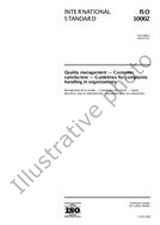We need your consent to use the individual data so that you can see information about your interests, among other things. Click "OK" to give your consent.

ISO/IEC 8632-1-ed.2.0
Information technology - Computer graphics - Metafile for the storage and transfer of picture description information - Part 1: Functional specification
Translate name
STANDARD published on 16.12.1999
| Language | |
| Format |
|
| Availability | IN STOCK |
| Price | ONREQUEST excl. VAT |
| ON REQUEST | |
|
Order including corrections
|
The information about the standard:
Designation standards: ISO/IEC 8632-1-ed.2.0
Publication date standards: 16.12.1999
SKU: NS-942894
The number of pages: 449
Approximate weight : 1378 g (3.04 lbs)
Country: International technical standard
Category: Technical standards ISO
The category - similar standards:
Annotation of standard text ISO/IEC 8632-1-ed.2.0 :
ISO/IEC 8632 provides a file format suitable for the storage and retrieval of picture description information. The file format consists of an ordered set of elements that may be used to describe pictures in a way that is compatible between systems of different architectures, compatible with devices of differing capabilities and design, and meaningful to application constituencies. This picture description includes the capability for describing static images. The elements specified provide for the representation of a wide range of pictures on a wide range of graphical devices. The elements are organized into groups that delimit major structures (metafiles, pictures, and application structures), that specify the representations used within the metafile, that control the display of the picture, that perform basic drawing actions, that control the attributes of the basic drawing actions, that allow application-specific structuring to be overlaid on the graphical content, and that provide access to non-standard device capabilities. The metafile is defined in such a way that, in addition to sequential access to the whole metafile, random access to individual pictures and individual context-independent application structures is well-defined. Applications which require random access to pictures and/or context-independent application structures within pictures may, within the metafile, define directories to these pictures and/or context-independent application structures. The metafile may then be opened and randomly accessed without interpreting the entire metafile. In addition to a functional specification, two standard encodings of the metafile syntax are specified. These encodings address the needs of applications that require small metafile size plus minimum effort to generate and interpret, and maximum flexibility for a human reader or editor of the metafile. This part of ISO/IEC 8632 describes the format using an abstract syntax. The remaining parts of ISO 8632 specify standardized encodings that conform to this syntax: ISO/IEC 8632-3 specifies a binary encoding; ISO/IEC 8632-4 specifies a clear text encoding.
These corrections apply to this standard:
Information technology - Computer graphics - Metafile for the storage and transfer of picture description information - Part 1: Functional specification - Technical Corrigendum 1
Correction published on 24.3.2006
Selected format:Show all technical information.
Information technology - Computer graphics - Metafile for the storage and transfer of picture description information - Part 1: Functional specification - Technical Corrigendum 2
Correction published on 30.10.2007
Selected format:Show all technical information.
We recommend:
Technical standards updating
Do you want to make sure you use only the valid technical standards?
We can offer you a solution which will provide you a monthly overview concerning the updating of standards which you use.
Would you like to know more? Look at this page.



 Cookies
Cookies
